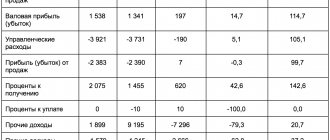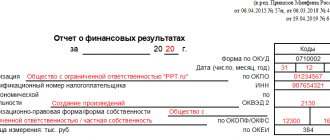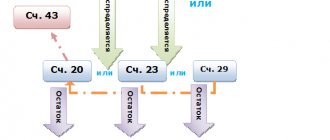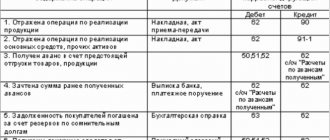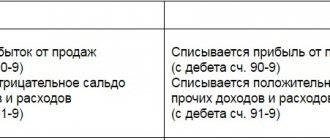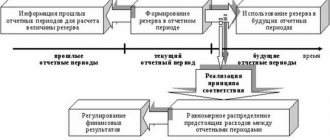How to reflect profit or loss from sales in accounting
Transactions for ordinary activities are recorded on the account. 90 "Sales". Here, revenue, cost, VAT, and excise tax indicators are collected in separate subaccounts. The financial result from this activity will be obtained arithmetically, and the accounting entries will look like this:
- Dt 90.9 Kt 99 - for fixing profits;
- Dt 99 Kt 90.9 - to record losses.
To learn how the cost price is collected, read the publication “What costs does the commercial cost of production include?”
The practical guide to preparing financial statements from ConsultantPlus shows in detail the procedure for reflecting retained earnings in the balance sheet.
Special payments from net profit are other expenses
Thus, in addition to losses from ordinary activities and other expenses, the debit of account 99 can only reflect expenses incurred by the organization due to emergency circumstances (natural disaster, fire, accident, flood, etc.), accrued income tax payments organizations, as well as the amount of tax penalties due. In this case, the following is reflected: loss from ordinary activities - in correspondence with account 90 “Sales”; the balance of other income and expenses for the reporting month - in correspondence with account 91 “Other income and expenses”; losses, expenses due to emergency circumstances of economic activity (natural disaster, fire, accident, nationalization, etc.) - in correspondence with accounts of material assets, settlements with personnel for wages, cash, etc.; the amount of accrued contingent income tax expense, permanent liabilities and payments for recalculation of this tax from actual profit, as well as the amount of tax penalties due - in correspondence with account 68 “Calculations for taxes and fees”. At the end of the reporting year, when preparing annual financial statements, account 99 “Profits and losses” is closed. In this case, by the final entry of December, the amount of net profit (loss) of the reporting year is written off from account 99 “Profits and losses” to the credit (debit) of account 84 “Retained earnings (uncovered loss)”. The construction of analytical accounting for account 99 “Profits and losses” should ensure the generation of data necessary for drawing up a profit and loss statement. Thus, initially, expenses written off from the organization's own funds are reflected in account 91 'Other income and expenses', subaccount 2 'Other expenses', and then monthly transferred to account 99. Debit 91-2 Credit 60 (for example) - expenses written off at the expense of the organization’s own funds; Debit 99 Credit 91-2 - expenses are included in financial results. The organization's own funds write off those expenses that are not taken into account for tax purposes in accordance with Article 270 of the Tax Code of the Russian Federation. According to the Instructions for filling out the income tax return of organizations, approved by Order of the Ministry of Taxes of the Russian Federation of December 29, 2001 N BG-3-02/585, the amounts of expenses incurred by the taxpayer, but not taken into account for tax purposes in accordance with Article 270 of the Tax Code, are indicated according to lines 290 - 310 of Appendix No. 2 to Sheet 02 “Costs associated with production and sales” of the income tax return. At the same time, the amounts of payments in favor of individuals, which, in accordance with paragraphs 21 - 29 of Article 270 of the Tax Code of the Russian Federation, are not taken into account for tax purposes, are shown separately. Line 310 indicates other expenses that do not meet the criteria specified in paragraph 1 of Article 252 of the Tax Code of the Russian Federation (clause 49 of Article 270 of the Tax Code of the Russian Federation). Line 311 separately shows the amount of payments in favor of individuals, if such expenses were taken into account as part of other expenses under paragraph 49 of Article 270 of the Tax Code of the Russian Federation. In this case, the indicated lines should reflect amounts that are not taken into account for tax purposes in accordance with Article 270 of the Tax Code of the Russian Federation, but recognized as expenses for accounting purposes in accordance with the Accounting Regulations “Organization Expenses” PBU 10/99, approved by the Order of the Ministry of Finance of Russia dated May 6, 1999 N 33n. In particular, expenses named in paragraphs 3, 5, 9, 12, 14, 19, 31, 32 of Article 270 of the Tax Code of the Russian Federation are not subject to reflection on these lines.
2.5.1. Expenses from net profit
In accordance with paragraph 1 of Article 270 of the Tax Code, when determining the tax base, expenses in the form of amounts of dividends accrued by the taxpayer and other amounts of distributed income are not taken into account. In other words, expenses incurred at the expense of net profit, that is, profit remaining after taxation, are not taken into account in the tax base for corporate income tax, regardless of the nature of such expenses.
For example, if a taxpayer made expenses for the repair of fixed assets from the amounts of distributed income, that is, from the profit remaining after taxation, such expenses on the basis of paragraph 1 of Article 270 of the Tax Code cannot be taken into account for profit tax purposes. This opinion was expressed by the Russian Ministry of Finance in a letter dated April 27, 2006 No. 03-03-04/1/406.
The courts come to the same conclusion. As an example, we can cite the resolution of the Federal Antimonopoly Service of the Volga-Vyatka District dated January 31, 2006 in case No. A17-1991/5/2005. In the case, the company's accountant expensed a bonus paid to the general director when calculating income taxes. But since this remuneration was paid out of the net profit received by the taxpayer, according to officials, it could not reduce taxable income. The taxpayer did not agree with the decision made by the tax authority and filed an application with the arbitration court.
The court sided with the tax inspectorate. This is how he reasoned. In accordance with paragraph 21 of Article 270 of the Tax Code of the Russian Federation, when determining the tax base, expenses for any types of remuneration provided to management or employees in addition to remuneration paid on the basis of employment agreements (contracts) are not taken into account. In this case, remunerations paid on the basis of employment agreements (contracts) are taken into account as part of labor costs in accordance with Article 255 of the Tax Code of the Russian Federation. Labor costs can be classified as payments that reduce the tax base for income tax only if such payments are reflected in the employment agreement (contract) concluded between the employer and the employee.
By virtue of paragraph 22 of Article 270 of the Tax Code of the Russian Federation, when determining the tax base for income tax, an organization does not take into account expenses in the form of bonuses paid to employees from special-purpose funds. In the situation under consideration, the retained net profit remaining at the disposal of the organization after taxation should be understood as special-purpose funds and determined by the owner of the organization for the payment of bonuses.
Where in accounting is information about net profit collected during the year?
To reflect the financial results of the enterprise's activities during the year, an account is used. 99 "Profits and losses." It is to this account that the financial results from sales and other activities are written off. In addition, on the account. 99 hit:
- accrual of conditional income tax;
What is a conditional expense and income tax income and how to correctly display it in accounting, find out in ConsultantPlus. Study the material by getting trial access to the K+ system for free.
- accrual of a single tax under the simplified tax system;
- accrual of a single tax for UTII;
ATTENTION! Starting from 2021, UTII will no longer be valid. Read more here.
- tax sanctions;
- losses associated with extraordinary circumstances;
- income received as a result of emergency circumstances;
- write-off of deferred tax assets and liabilities;
- other income or expense items.
As a result of analyzing the account turnover for the year, you can understand whether the enterprise’s activities were profitable or not. If the debit turnover exceeds the credit turnover of the account. 99, then the organization worked at a loss, and if vice versa, then the year ended with a profit. The balance sheet reformation ends with a record reflecting the financial results of all the organization’s activities for the year:
- Dt 99 Kt 84 - profit accrued;
- Dt 84 Kt 99 - the entry means that the activity for the year was unprofitable.
To better understand the process of generating profit or loss, read about which accounts are active.
Payments from net profit
Our company paid for a medical operation for its employee from its net profit. Thus, we did not pay any taxes. As I understand it, there should be only one entry here: Debit 99 Credit 50? Right?
According to clause 12 of PBU 10/99 “Expenses of the organization”
, approved by order of the Ministry of Finance of the Russian Federation dated May 6, 1999 No. 33n, the expenses incurred by you for accounting purposes are recognized as
non-operating expenses
.
In accordance with the Instructions for using the Chart of Accounts... expenses recognized as non-operating are reflected during the reporting period in the debit of account 91 “Other income and expenses”
.
account 99 “Profits and losses” to reflect such expenses
The chart of accounts... is not provided for, since account 99 “Profits and losses” during the reporting year reflects:
– profit or loss from ordinary activities
– in correspondence with account 90 “Sales”;
– balance of other income and expenses
for the reporting month - in correspondence with account 91 “Other income and expenses”;
– losses, expenses and income due to emergency circumstances
economic activity (natural disaster, fire, accident, nationalization, etc.) - in correspondence with accounts of material assets, settlements with personnel for wages, cash, etc.;
– amount of accrued contingent expense
for income tax, permanent liabilities and payments for recalculation of this tax from actual profit, as well as the amount of
tax penalties
- in correspondence with account 68 “Calculations for taxes and fees”.
Entries in subaccounts 91-1 “Other income” and 91-2 “Other expenses” are made cumulatively during the reporting year.
By monthly comparison of debit turnover in subaccount 91-2 “Other expenses” and credit turnover in subaccount 91-1 “Other income”, the balance of other income and expenses for the reporting month is determined.
This balance is written off monthly (with final turnover) from subaccount 91-9 “Balance of other income and expenses” to account 99 “Profits and losses”.
Payment for the transaction will be reflected in the following entry:
DEBIT 76 CREDIT 50
– payment has been made to the medical institution for the operation;
DEBIT 91 subaccount “Other expenses” CREDIT 76
– expenses for payment of the operation are recognized.
For profit tax purposes, expenses for employee treatment are not taken into account.
neither in the reporting period nor in subsequent periods.
And for accounting purposes, these expenses are taken into account.
Consequently, according to clause 4 of PBU 18/02 “Accounting for income tax calculations”
a permanent difference
is formed in accounting .
Permanent differences of the reporting period are reflected in accounting separately (in the analytical accounting of the corresponding account of assets and liabilities in the assessment of which a permanent difference arose).
a permanent tax liability is recognized in accounting
.
The permanent tax liability is equal to
the value determined as the product of the permanent difference that arose in the reporting period by the profit tax rate established by the legislation of the Russian Federation and in force on the reporting date.
Constant tax liabilities are reflected in accounting in account 99 “Profits and losses”
subaccount “Permanent tax liability” in correspondence with the credit of
account 68
.
The conditional income tax expense is subject to adjustment (increase) by the amount of the permanent tax liability.
(tax accrued on the basis of accounting profit), as a result of which the amount of current income tax payable to the budget is determined.
Payments for the treatment of employees can also be made from retained earnings.
.
In accordance with the norms of the Federal Law of the Russian Federation dated 02/08/1998 No. 14-FZ “On Limited Liability Companies”
and the Federal Law of the Russian Federation of December 26, 1995 No. 208-FZ
“On Joint-Stock Companies”,
only the owners of the organization
can dispose of the profit remaining at the disposal of the company after paying taxes .
The decision on payments from retained earnings must be reflected in the minutes of the general meeting of owners
.
In this case, the accounting entries will be as follows:
DEBIT 76 CREDIT 50
DEBIT 84 CREDIT 76.
do not apply in this case
.
Retained earnings and its use in accounting
Retained earnings (uncovered loss) are reflected in the account of the same name. 84. Its debit balance indicates accumulated loss, and its credit balance indicates profit. By decision of the owners of the enterprise, expenses can be made at the expense of the organization’s profits or losses can be repaid from any sources.
The practical guide to preparing financial statements from ConsultantPlus shows in detail the procedure for reflecting retained earnings in the balance sheet. If you do not have access to the K+ system, get a trial online access for free.
Retained earnings can be used for the following expenses:
- payment of dividends - Dt 84 Kt 75 (or Dt 84 Kt 70, if one of the dividend recipients is an employee of the enterprise);
- formation of reserve capital - Dt 84 Kt 82;
- increase in authorized capital - Dt 84 Kt 80.
The loss, by decision of the owners, can be repaid:
- from profit - Dt 84 Kt 84 using the corresponding subaccounts;
- founders' funds - Dt 75 Kt 84;
- reserve capital - Dt 82 Kt 84;
- authorized capital (but with the condition that its amount does not become less than the amount of net assets) - Dt 80 Kt 84;
- additional capital, if there are no other sources - Dt 83 Kt 84.
Analysis of unproductive expenses at the expense of net profit
Analysis of cost reduction and changes in profit under the influence of main technical and economic factors 3.2 Change in costs due to improved labor organization Measures to increase labor productivity, reduce labor intensity, improve labor standards, etc. are taken into account here. Changes are determined by the formula:... Analysis of cost reduction and changes in profit under the influence of main technical and economic factors 3.3 Change in costs due to the elimination of losses from defects and unproductive expenses Expenses from defects at the enterprise are not planned and are calculated only in actual cost. Unproductive expenses include various losses due to failures in the production process (downtime of equipment, workers, transport...
On the debit of subaccount 81-2, the enterprise reflects the write-off of amounts from the net profit of the enterprise (credit to accounts 06, 10. Analysis of the enterprise's expenses and distribution of profits. To be honest, I do not agree. The employee takes the money, which means it must be accounted for. The accountant attributed the amount to the consumables expenses at the expense of net profit (or not going to deductions) 821.2, according to IFRS attention here: debit - expenses, credit - money, everything is normal.
Posting - at the expense of net profit. If I am not mistaken. Posting according to D84 can be done if expenses from last year are found. And now all costs are 20,44,26, 91. And in tax accounting, you are already forming the taxable base. And these are no longer accounts, but tax registers. To be honest, I don’t see any FUNDAMENTAL changes. Whatever side you look at the pipe, it is a pipe. 6.5.1. The debit of account 99 “Profits and Losses” reflects losses (losses, expenses), and the credit shows the profits (income) of the organization. How to write off expenses from the funds remaining with the organization after paying income tax The net profit of an enterprise can only be disposed of by its owners, so you need to obtain the appropriate decision of the owner (or owners) in the form of a decision of the general meeting or a decision of the board of directors. Therefore, the expression at the expense of net profit apparently does not accurately reflect the situation, so it is better to talk about expenses that are not taken into account in reducing the tax base for income tax. Is it possible to attribute the amount to expenses at the expense of net profit immediately in the consumables? The accountant attributed the amount in the consumables to expenses at the expense of net profit (or not going to deductions) account 821.2, according to IFRS here: debit - expenses, credit - money, everything is normal .But in my practice, this has never happened.
Results
The results of an enterprise's economic activities are collected on several accounting accounts.
The main thing to remember is that profit is collected on credit, and loss on debit. This means that the debit balance on the account. 99 during the year, as well as the accumulated account balance. 84 speak about the organization’s loss, and credit residual indicators speak about its profit. You can find more complete information on the topic in ConsultantPlus. Free trial access to the system for 2 days.
